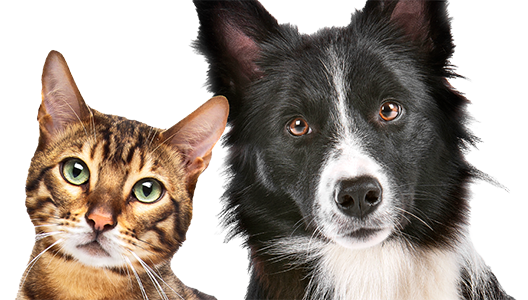Selecting the Right Pet for You
Puppies and kittens are babies. And whether they’re playing or sleeping, all babies are cute, cuddly and fun to watch. It’s amazing to watch a baby grow, explore and learn. At the same time, we can’t predict the personality a baby will have as an adult. It’s impossible to look at the rows of human babies in a hospital nursery and know who will be athletic or academic, quiet or talkative, high-or low-energy, artistically or mechanically gifted, sociable or a “loner.”
Many physical and personality traits of certain types or breeds of dogs and cats are fairly predictable. Some are good traits, like hair color, eagerness to please, and the urge to retrieve; some are bad, like congenital health problems or a compulsion to dig. But even when we know what a breed is supposed to be like, we never know with certainty that an infant will grow up a typical member of that breed. Like human babies, every kitten and puppy will develop into an individual with a unique personality and preferences, shaped by both inherited and learned traits.
Many people assume that puppies or kittens are the only “right” age for a new pet to be introduced into the family, but an older pet is actually more suitable for many situations. Pets of any age can bond with the people who love and care for them, giving as much to the relationship as they receive in return. Some older animals may need extra time to adjust and learn to trust (especially if they were mistreated in their prior homes), but the fact remains that most adult cats and dogs can bond with their new families as deeply as puppies or kittens raised from babyhood.
If you’re looking for a pet with certain personality traits, it’s more likely that you’ll find the right companion to fit your lifestyle if the candidate is at least six months old. The first six months of life are vital to the development of puppies and kittens and require a lot of time, care and energy. Many households are not able to provide what is needed during this busy period of high-rate learning and growing (see our handouts: “Puppy Behavior Basics” and “Kitten Behavior Basics“). “Teenage” or young adult pets (for most breeds, between six months and 16 months of age) may know more about appropriate behavior, but they’re still high-energy “kids” at this stage and will test your patience at every turn.
If you don’t have the patience or energy for a teenager, you should consider an adult dog or cat that is at least one year to 18 months old. Dogs and cats this age learn quickly, have more coordination and control over their physical functions, and have more predictable natures.
To help you weigh the “pros” and “cons” of adopting an adult vs. a puppy or kitten, ask yourself these important questions:
First: Do you really have the time, energy, space and money for a pet? It’s a huge commitment, and one that lasts a lifetime (your pet’s).
How much time do you spend at home on an average day? Puppies and kittens need more physical and emotional involvement with people than adult animals do. If you’re from home more than six hours a day, you won’t be able to give your pup/kitten enough of your time. Most adult pets can easily adjust to your schedule, but, they also need time to learn what is expected of them. Some dogs never grow accustomed to being left alone. If all your family members are away from home more than eight hours most days, a dog may not be an appropriate choice for your household, and you might want to consider adopting an adult cat (or two) instead.
Are there children in my home? How many? How old? While many families think they want “a pet for the children,” it takes a special combination of parent/child/pet to do this well. A family pet does offer children a wonderful opportunity to learn about caring and responsibility, but regular pet care duties need to be carefully supervised by an adult. A child should never be solely responsible for a pet. You also need to keep in mind that your child’s life and interests will change over the next ten to 15 years. The ultimate responsibility for a pet’s care and safety is that of the adults in the household.
If your child is under six years old, your pet should be over four months old. Puppies and kittens play roughly, and without careful supervision and training, both your child and your pet could have a bad experience with potentially serious consequences. An adult pet is usually past the stage of becoming overly excited, and more easily predictable about how patient and tolerant he’ll be with kids’ energy.
It’s your responsibility to monitor the interaction between your child and your pet, and to teach your child how to show respect for your pet’s needs and feelings. Teach by example that your pet is an important family member, and not a “plaything” you can neglect or toss away when it’s longer new or exciting.
Will this pet be a companion to another pet? Most pets like to have at least one “buddy.” You might want to consider adopting a pair of adult pets that are already accustomed to and attached to each other. Many pets (especially cats) are surrendered to shelters in “pairs” because their human families are no longer able to care for them. There are many benefits to keeping a pair together.
If you’re bringing a new pet into a household that already has a pet, it’s best to introduce a younger animal… but not one that’s too young, as some older cats or dogs may respond to a very young kitten or puppy as prey to be hunted. In addition, the older resident pet may not like the constant movement and playful energy. Very young pets lack the social ability to read your older pet’s irritation, as well as the reflexes to escape if the situation becomes tense. The best age range to introduce a puppy or kitten to your current adult pet is between four and 14 months old.
Do I want a pet that will participate with me in outdoor activities? Dogs involved in outdoor-type activities must have excellent manners, and be good travelers. Many pets (like many people) don’t travel well. Some reasons for chronic carsickness can be remedied, but if you specifically want a pet to travel with you to local activities or on short vacations, don’t expect miracles from a young animal. There is no way to tell which pet will have the stomach for it. To teach your dog good manners, you will need to build a strong relationship with him/her, and commit to ongoing obedience training. Are you willing and able to do that?
If you want a dog to take hiking and camping, to play ball or swim in the lake with, or to train to catch flying discs, you should consider a teenage or young adult dog. For major outdoor activities, a dog should be a certain minimum size and have natural hardiness. Not all dogs (even retrievers) are naturally inclined toward catching things. It’s important to find the right combination of traits to fit your particular criteria.
Do I want a “lap-pet” that will be physically affectionate and cuddly? Most puppies and kittens will accept some physical affection, but they don’t all grow up to be pets that like to be cuddled. This is another good example of a specific personality trait that will be easier to find in an adult animal.
Do I prefer a certain physical appearance, coloring or coat? If you like big cats, shiny dogs or fluffy coats, you can do some “educated guessing” with a puppy or kitten, but you’ll still be guessing. By the time a cat or dog is about six months old, though, these physical traits will be clear – plus you’ll be able to see what kind of personality traits go along with the “package.”
How large is “too large” for my lifestyle? If you’re renting your home, you’ll want to check the pet policies in your rental contract or lease for any size limitations. Puppies and kittens grow into adult animals, and believe it or not, thousands of puppies and kittens lose their homes each year because someone didn’t think about what their adult size would be. Many large dogs are surrendered to animal shelters because they were cute, little, fluffy puppies one week and big, clumsy, enthusiastic teenagers the next.
If you have a specific size in mind for your ideal pet, don’t rely on guessing and optimism. You can usually tell what size cats and most dogs will be when they’re fully grown by the time they’re six or seven months old.
Adapted from Dumb Friends League and Humane Society of the United States. All rights reserved.























































